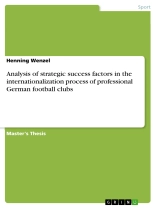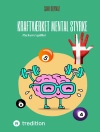Master’s Thesis from the year 2015 in the subject Sport – Sport Economics, Sport Management, grade: 1, 5, University of applied sciences, Cologne, language: English, abstract: This thesis aims to analyse professional German football clubs and their strategic approaches while internationalizing, providing a profound insight into the topic: “Analysis of strategic success factors in the internationalization process of professional German football clubs”.
The primary research question of this work is why, where and when professional German football clubs are entering foreign markets and which strategic processes have to be considered during the internationalization process, furthermore, which are successful? In addition, this study strives toward a better understanding of internationalization strategies of professional German football clubs analysing how they are internally structured as well as which internal and external factors could influence the internationalization?
In order to evaluate the different strategic approaches “strategy profiles” for selected clubs are going to be considered based on structured quantitative interviews and compared as case studies. In this thesis, the research focuses on selected German Bundesliga clubs. Due to their financially weaker situation and lack of international importance, clubs from the Bundesliga 2 will not be considered. The mentioned selected clubs are Borussia Dortmund Gmb H & Co. KGa A, FC Gelsenkirchen-Schalke 04 e.V. and Vf L Wolfsburg-Fußball Gmb H. In addition, in order to analyse the collaboration between the clubs and the German Football Association (DFL Deutsche Fußball Liga Gmb H), the relationship between the clubs and the DFL will be examined.
For the structured interviews with experts the author of this thesis developed an interviewer administered questionnaire guiding through the different interviews. Each interviewed expert was asked to respond to the same set of questions in a predetermined order. Trying to build a broad opinion profile and to create a better possibility of comparison at a uniform level, interviews with experts from the recently most successful and aspiring German Bundesliga clubs were conducted (Alexander Jobst, Thomas Röttgermann, Benedikt Scholz). Additionally, to analyse the interdependence between the clubs and the DFL an interview with the CEO of the DFL (Christian Seifert) was conducted. Due to the financially weaker situation and lack of international importance, clubs from the Bundesliga 2 were not considered.
Cuprins
List of Abbreviations
List of Figures
List of Tables
1 Introduction
1.1 Problem Statement
1.2 Aim of the Work
1.3 Research Method
1.4 Structure
2 Fundamentals of Internationalization Strategies
2.1 History and Definitions of Strategy
2.2 Phases of the Strategic Process
2.3 Types of Strategies
2.3.1 Corporate Strategy
2.3.2 Business Strategy
2.3.3 Intended and Emergent Strategies
2.3.4 Alternative Views of Strategy
2.4 Basics of Internationalization
2.4.1 Definition and Characteristics
2.4.2 Motives and Drivers for Internationalization
2.4.3 Benefits of Internationalization
2.4.4 Stages of Internationalization
2.5 Process of Market Entry
2.5.1 Target Markets and Emerging Markets
2.5.2 Timing of Entry
2.5.3 Market Entry Strategies
2.5.4 Export
2.5.5 Licensing
2.5.6 Strategic Alliance
2.5.7 Subsidiaries
3 Internal and External Factors for Internationalization Strategies
3.1 Strategic Analysis and Tools
3.1.1 SWOT-Analysis
3.1.2 PEST-Analysis
3.1.3 Porters Five Forces Framework
3.1.4 Market Research
3.2 International Economic and Country Analysis
3.3 Organizational Structures
3.4 Role of Culture
3.5 Political Environment and Country Risk
3.6 Consumer Behaviour
4 Characteristics of the professional German Football Market
4.1 The Business of Football
4.2 Structure of the Professional German Football Market
4.2.1 The History of Professional German Football
4.2.2 Facts and Figures of the Bundesliga
4.2.3 Legal Structure of the Bundesliga
4.3 Economic Characteristics of professional German Football Companies
4.3.1 Change of Legal Structures
4.3.2 Aims of Football Companies
4.3.3 Internal and External Financing
5 Case Studies of Internationalization Strategies
5.1 Selection and Fact Sheets of the Analysed Football Clubs
5.2 Position in the Internationalization Process
5.3 Organisational Structure
5.4 Motives of Internationalization
5.5 Market Conditions
5.6 Target Markets
5.7 Mode of Entry and Timing
5.8 Strategic Partners
5.9 Collaboration between Clubs and DFL
5.9.1 Role of the DFL
5.9.2 International Subsidies
5.9.3 International Media Markets and Trends
5.10 Strategic Success Factors and Risks
6 Critical Analysis and Recommendation
7 Conclusion
8 Appendix
8.1 Appendix 1: Interview – Alexander Jobst
8.2 Appendix 2: Interview – Thomas Röttgermann
8.3 Appendix 3: Interview – Benedikt Scholz
8.4 Appendix 4: Interview – Christian Seifert
Bibliography












